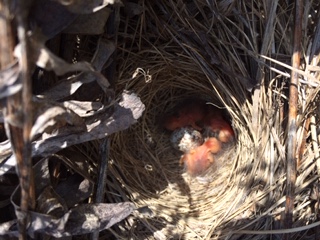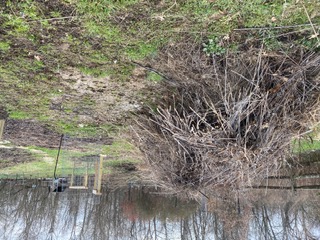Blog
Brush Pile? It’s Habitat, Not Waste!
By Jason Neumann, Public Programs Manager
My mother is fond of saying “you could sell a dirty oil rag.” Turning garbage into something of value has always been one of my favorite things to do. I’ve been pondering this as I pick up all the winter-fallen sticks and pruned off branches in my yard. All that woody debris can go towards creating brush piles for wildlife. You’d think it would be easy -- how hard is it to throw all your sticks in pile? The brush pile building inspector won’t be showing up at your door but there are actually some best practices for crafting your pile to assure its useful for wildlife and aesthetically pleasing for humans.

What a brush pile does for wildlife: The tangle of branches in a brush pile allows birds and small mammals to escape from predators as well as shelter from intense heat, cold, and wind. Those butterflies that come to your flowers? They may overwinter as chrysalises in brush piles as do a myriad of other beneficial insects. Some birds nest in the safety of the jumble of sticks a brush pile provides. Over the longer term, the nutrients bound up in woody waste are slowly recycled as the branches decompose.
Placement: Locate your brush pile away from your house (we don’t want to be so inviting that we draw wildlife into the house), placing your brush pile in a discreet corner of the yard. Avoid wet areas. Site your pile so that it becomes a wildlife travel lane between habitat features such as between the edge of the woods and lawn or between a bird feeder and tree. If you have a larger lot, consider multiple brush piles.

Construction: Shoot for the Goldilocks zone. You’ll want your brush pile to be dense enough to provide shelter and constrain predators but loose enough to provide access by small wildlife. This is accomplished by placing layers of brush perpendicular to the one another as you add to the pile. If you have larger logs, space them out on the bottom. A brush pile that’s 8-10 feet long and 4-5 feet tall will be useful for wildlife.
Aesthetics: Not all communities allow brush piles so be sure you know the rules. Where permitted, turn your brush pile into an “I’m a brush pile-maker and I’m proud” landscape feature or sequester it behind mature shrubs, plant taller perennial wildflowers around it, or plant a native trailing vine to sprawl over the pile (native Virgin’s Bower, Clematis virginiana, is a great choice).
If you’re able, skip the curbside brush pick up. Turn your woody waste into valuable real estate for wildlife.
This link has a great diagram of how to build a brush pile: https://content.yardmap.org/learn/brushpiles/
https://www.nrcs.usda.gov/Internet/FSE_DOCUMENTS/stelprdb1081685.pdf